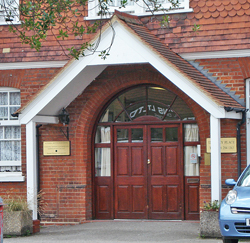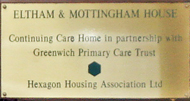Eltham and Mottingham
Cottage Hospital
Cottage Hospital
32 Passey Place, Eltham, SE9 5DH
Medical dates:
Medical character:
General
Eltham Cottage Hospital opened
on 7th October 1880 at No. 9, High Street, Eltham. It had been
founded mainly by wealthy local residents and was staffed by a
nurse, a cook and an unpaid Superintendent.
In 1896 the Hospital Committee decided that the building was too small, and unsuitable for extension or improvement. A public meeting was held in the following year to discuss the possibility of building a purpose-built hospital elsewhere. A Building Committee was appointed, funds were pledged and the search began for a suitable site for the new hospital.
A plot of land in Park Place (later renamed Passey Place) was chosen and the architect and builder appointed. The hospital was to be built to commemorate the Diamond Jubilee of Queen Victoria. Fund-raising began in earnest.
The Eltham and Mottingham Cottage Hospital was officially opened on 3rd December 1898 by Sir Henry Burdett (1847-1920). Built on the pavilion system, it consisted of an administration block and a ward block with 10 beds in two wards. There were also two private wards and a bathroom, and an operating theatre. It had cost some £4,000.
In 1900 the Hospital was extended and, in 1906, a children's ward with 10 beds was added, the gift of Mrs Grain. In 1909 a Casualty Ward was opened because of the increase in road traffic accidents.
In 1911 Mrs Latter of Southend Hall donated an X-ray apparatus to the Hospital as a memorial to King Edward VII.
When Dr James Jeken, one of the founders of the Hospital, died in January 1913, a covered verandah was added to the rear of the ward building in his memory.
In 1926 Mrs Locket, the daughter of Colonel North of Avery Hill, provided funds for a new block as a memorial for members of her family. The 2-storey building would contain six private rooms on the ground floor and six bedrooms for nurses on the floor above (the building was later used for maternity patients). The Hospital then had 26 beds, a Casualty Department, but no Out-Patients Department.
In 1930 the weekly cost of an in-patient was £5 13s 3d (£5.66), compared to £7 1s 3d (£7.06) in 1929.
In 1930 the violinist Yehudi Menuhin visited a patient, a fellow musician named Corinne Hay, who had been taken ill and had been unable to attend his concert at the Albert Hall. He gave an impromtu recital for her and the other patients.
The Hospital was extended on the south side in 1933, when a legacy from Mr and Mrs Arthur Mills of Grangehill Road enabled an 8-bedded ward (the Mills Ward) to be added, as well as an isolation room, and bath and sluice rooms. The first floor of the block contained five bedrooms and a sitting room for the nursing staff.
During WW2 the Hospital joined the Emergency Medical Service, with 39 beds reserved for air-raid casualties.
During the 1940s a small house backing onto the Hospital buildings was used as a Preliminary Training School for nurses, with a converted garage acting as a classroom.
Between the Preliminary Training School and the Hospital were sizeable gardens, in which a large hut was erected in 1947 as an Out-Patients Department. The hut also housed offices for the Almoner, Medical Records Department and the Casualty Department. However, the arrangement was not ideal as stretcher cases on their way to Casualty had to traverse the length of the hut, through many doors, weaving between those patients attending for other purposes.
In 1948 the Hospital joined the NHS under the control of the Woolwich Group Hospital Management Committee, part of the South East Metropolitan Regional Hospital Board.
In 1949 the Management Committee decided to close the maternity unit on the grounds that it was too small.
By 1956 the Hospital had 42 beds but, apart from the ward block built shortly before the war, the wards were old-fashioned. Bed curtains were added around each bed to replace the screens, granting the patients greater privacy. Staff accommodation was also inadquate. The 12 nurses who had bedrooms above the wards could not put on the wireless (radio) or make other noise in case they disturbed the patients. The nursing staff also had no Recreation Room and the Dining Room was so small that it took three sittings to feed the whole staff.
Following a major reorganisation of the NHS in 1974, the Hospital came under the administration of the Greenwich District Health Authority, part of the South East Thames Regional Health Authority.
The Hospital closed in 1980.
Present status (June 2008)
After the Hospital closed, the buildings were boarded up, but soon became vandalized. From 1984 to 1988 part of the premises were used by the Brook Hospital Charity Shop.
In 1988 work began to convert the buildings into a nursing home for the elderly, and Eltham and Mottingham House opened on 5th December 1989. It had 24 beds and was managed by the Hexagon Housing Association in conjunction with the Greenwich Primary Care Trust. Another part of the premises was used by Bexley and Greenwich Health Promotions.
In 2007 plans were being made to build a community hospital on the site.
Update (July 2012)
The nursing home closed in 2010 in anticipation of the new £18m community hospital. An adjacent empty house, No. 34 Passey Place, was purchased to increase the size of the plot.
Originally planned to open in 2012, work has yet to begin on demolition of the nursing home, the Passey Place Health Centre (now closed) and No. 34 Passey Place.
The Eltham Community Hospital is now due to open in autumn 2014. It will include 40 care beds, a GP surgery and an Urgent Care Centre.
In 1896 the Hospital Committee decided that the building was too small, and unsuitable for extension or improvement. A public meeting was held in the following year to discuss the possibility of building a purpose-built hospital elsewhere. A Building Committee was appointed, funds were pledged and the search began for a suitable site for the new hospital.
A plot of land in Park Place (later renamed Passey Place) was chosen and the architect and builder appointed. The hospital was to be built to commemorate the Diamond Jubilee of Queen Victoria. Fund-raising began in earnest.
The Eltham and Mottingham Cottage Hospital was officially opened on 3rd December 1898 by Sir Henry Burdett (1847-1920). Built on the pavilion system, it consisted of an administration block and a ward block with 10 beds in two wards. There were also two private wards and a bathroom, and an operating theatre. It had cost some £4,000.
In 1900 the Hospital was extended and, in 1906, a children's ward with 10 beds was added, the gift of Mrs Grain. In 1909 a Casualty Ward was opened because of the increase in road traffic accidents.
In 1911 Mrs Latter of Southend Hall donated an X-ray apparatus to the Hospital as a memorial to King Edward VII.
When Dr James Jeken, one of the founders of the Hospital, died in January 1913, a covered verandah was added to the rear of the ward building in his memory.
In 1926 Mrs Locket, the daughter of Colonel North of Avery Hill, provided funds for a new block as a memorial for members of her family. The 2-storey building would contain six private rooms on the ground floor and six bedrooms for nurses on the floor above (the building was later used for maternity patients). The Hospital then had 26 beds, a Casualty Department, but no Out-Patients Department.
In 1930 the weekly cost of an in-patient was £5 13s 3d (£5.66), compared to £7 1s 3d (£7.06) in 1929.
In 1930 the violinist Yehudi Menuhin visited a patient, a fellow musician named Corinne Hay, who had been taken ill and had been unable to attend his concert at the Albert Hall. He gave an impromtu recital for her and the other patients.
The Hospital was extended on the south side in 1933, when a legacy from Mr and Mrs Arthur Mills of Grangehill Road enabled an 8-bedded ward (the Mills Ward) to be added, as well as an isolation room, and bath and sluice rooms. The first floor of the block contained five bedrooms and a sitting room for the nursing staff.
During WW2 the Hospital joined the Emergency Medical Service, with 39 beds reserved for air-raid casualties.
During the 1940s a small house backing onto the Hospital buildings was used as a Preliminary Training School for nurses, with a converted garage acting as a classroom.
Between the Preliminary Training School and the Hospital were sizeable gardens, in which a large hut was erected in 1947 as an Out-Patients Department. The hut also housed offices for the Almoner, Medical Records Department and the Casualty Department. However, the arrangement was not ideal as stretcher cases on their way to Casualty had to traverse the length of the hut, through many doors, weaving between those patients attending for other purposes.
In 1948 the Hospital joined the NHS under the control of the Woolwich Group Hospital Management Committee, part of the South East Metropolitan Regional Hospital Board.
In 1949 the Management Committee decided to close the maternity unit on the grounds that it was too small.
By 1956 the Hospital had 42 beds but, apart from the ward block built shortly before the war, the wards were old-fashioned. Bed curtains were added around each bed to replace the screens, granting the patients greater privacy. Staff accommodation was also inadquate. The 12 nurses who had bedrooms above the wards could not put on the wireless (radio) or make other noise in case they disturbed the patients. The nursing staff also had no Recreation Room and the Dining Room was so small that it took three sittings to feed the whole staff.
Following a major reorganisation of the NHS in 1974, the Hospital came under the administration of the Greenwich District Health Authority, part of the South East Thames Regional Health Authority.
The Hospital closed in 1980.
Present status (June 2008)
After the Hospital closed, the buildings were boarded up, but soon became vandalized. From 1984 to 1988 part of the premises were used by the Brook Hospital Charity Shop.
In 1988 work began to convert the buildings into a nursing home for the elderly, and Eltham and Mottingham House opened on 5th December 1989. It had 24 beds and was managed by the Hexagon Housing Association in conjunction with the Greenwich Primary Care Trust. Another part of the premises was used by Bexley and Greenwich Health Promotions.
In 2007 plans were being made to build a community hospital on the site.
Update (July 2012)
The nursing home closed in 2010 in anticipation of the new £18m community hospital. An adjacent empty house, No. 34 Passey Place, was purchased to increase the size of the plot.
Originally planned to open in 2012, work has yet to begin on demolition of the nursing home, the Passey Place Health Centre (now closed) and No. 34 Passey Place.
The Eltham Community Hospital is now due to open in autumn 2014. It will include 40 care beds, a GP surgery and an Urgent Care Centre.

The former Hospital, looking much like a suburban house.

The main entrance.

The brass plate for Eltham and Mottingham House to the left of the front door.

The northern elevation of the building, looking down the path towards the Clinical Psychology Unit, housed in new premises and run by the Oxleas NHS Foundation Trust.

Passey Place Health Centre, next door to the former Hospital, provided services for the Greenwich Primary Care Trust and Oxleas NHS Foundation Trust.
(Author unstated) 1898 Untitled. British Medical Journal 2 (1980) 1750.
http://content.yudu.com
http://hospitalshistory.multiply.com (1)
http://hospitalshistory.multiply.com (2)
www.bexley.nhs.uk
www.cnplus.co.uk
www.communityhealthpartnerships.co.uk
www.elthamtcp.co.uk
www.london-footprints.co.uk
www.nera-se9.com
www.newshopper.co.uk
www.webarchive.greenwichpct.nhs.uk (1)
www.webarchive.greenwichpct.nhs.uk (2)
Return to home page